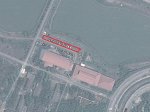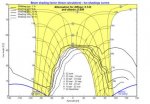Hi guys,
I have to design a solar parking for the company im working with. The building is in front of the parking so it will be shaded after noon during 3 months a year.
Click image for larger version.


The height difference between the first module and the last is about 2.5 meter so the panels distribution will be in 13 stages with a difference in height of 15cm. It will lead to a 2 different directions shading, one from the stages(whole year) and the other from the building(3 monts)
The first configuration I have simulated is filling up each stage with modules utilizing the total stage area


When I consulted some people they told me to avoid the shade generated by the height difference between stages, otherwise the diodes would be damaged quickly. According to their advise I simulated another configuration, leaving a 50 cm gap between stages and setting them in landscape in order to lengthen the diodes life as much as possible.


System description:
-234 modules (Canadian Solar CS6P-250P, 250 W). Each module has 3 Schottky diodes (one per 20 cells)
- Inverters: Leonics Apollo GTP-4000TL (P). 15 KW x 4 units. 2 MPPTs with a voltage range 380v-800v
I have contacted Canadian Solar technical department but is difficult to get an answer so I hope you could give me your opinion and help.
- Despite leaving the 50 cm gap between stages, there will be a bit of shade after 17-17:30 (less than 250 W/m2). I dont think it will affect the diodes life but anyway tell me please if im wrong.
- I assume that the diodes life will be shortened by the 3 months shade from the building. Looking at the iso-diagram and configuration, Do you think it will become a problem? I would not like to damage any module or change any diode before 10-15 years.
- Any suggestion to extend and improve the life of the modules/diodes?
THANK YOU IN ADVANCE
I have to design a solar parking for the company im working with. The building is in front of the parking so it will be shaded after noon during 3 months a year.
Click image for larger version.


The height difference between the first module and the last is about 2.5 meter so the panels distribution will be in 13 stages with a difference in height of 15cm. It will lead to a 2 different directions shading, one from the stages(whole year) and the other from the building(3 monts)
The first configuration I have simulated is filling up each stage with modules utilizing the total stage area


When I consulted some people they told me to avoid the shade generated by the height difference between stages, otherwise the diodes would be damaged quickly. According to their advise I simulated another configuration, leaving a 50 cm gap between stages and setting them in landscape in order to lengthen the diodes life as much as possible.


System description:
-234 modules (Canadian Solar CS6P-250P, 250 W). Each module has 3 Schottky diodes (one per 20 cells)
- Inverters: Leonics Apollo GTP-4000TL (P). 15 KW x 4 units. 2 MPPTs with a voltage range 380v-800v
I have contacted Canadian Solar technical department but is difficult to get an answer so I hope you could give me your opinion and help.
- Despite leaving the 50 cm gap between stages, there will be a bit of shade after 17-17:30 (less than 250 W/m2). I dont think it will affect the diodes life but anyway tell me please if im wrong.
- I assume that the diodes life will be shortened by the 3 months shade from the building. Looking at the iso-diagram and configuration, Do you think it will become a problem? I would not like to damage any module or change any diode before 10-15 years.
- Any suggestion to extend and improve the life of the modules/diodes?
THANK YOU IN ADVANCE

